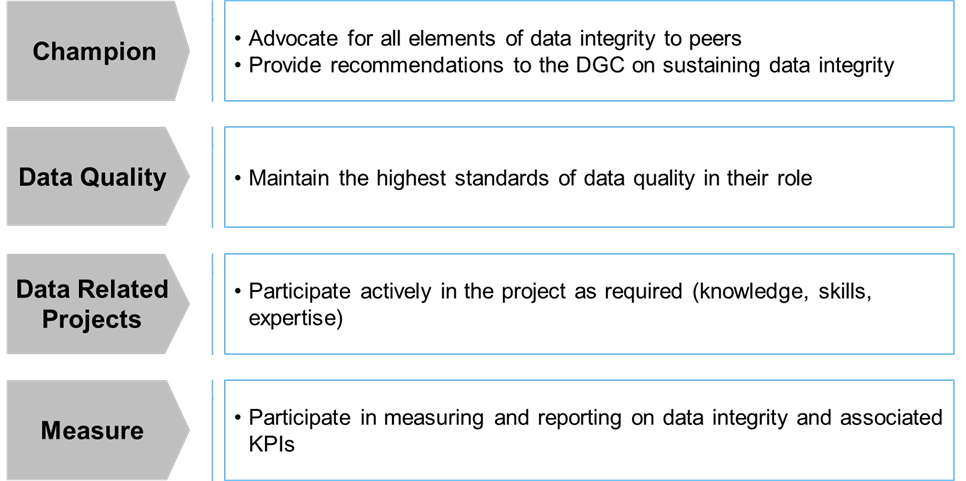In many organizations, confusion exists about who has responsibility for MRO data ownership (maintaining your MRO materials data in the company’s item master), crucial for effective MRO maintenance versus who are the users or beneficiaries of the data. Often, the owners and the beneficiaries of the data are not the same.
The owner of the data would be the organization that is accountable for maintaining and ensuring the highest quality and accuracy of the data, making sure duplicate records of the same item are not created, and confirming the data is complete with no critical values missing. Typically, the beneficiaries supply an MRO item’s accurate data values to the owners to enable creation of an item record in the database.
The issue of owner versus beneficiary becomes more crucial when there is an enterprise MRO item master (database) at the corporate level that processes records of MRO items for multiple plants/facilities. In this case, the item master at the enterprise level may contain thousands of items, yet one plant in the organization may only need to access 10 percent of those MRO item records for its plant’s usage. Typically, this subset of data is called the branch item master, whereas at the corporate level, it is considered the enterprise item master.
Process Precision and Well-Defined Roles and Responsibilities Prevent Big Problems
Using the wrong process for your corporate culture, and not assigning clear data quality management responsibilities to specific job descriptions in your organization, will cause your data to become corrupt and/or inaccurate. As data corruption builds in the system, it will continue to breed mistrust in those beneficiaries of the data.
In organizations with an imperfect process, there is a strong likelihood of expensive waste in both material costs and labor time:
- In the item master, 15% – 18% of items are duplicated.
- Of the parts in your storeroom, 30% will never be used.
- Wasted expensive shelf space and carrying costs will result due to non-moving inventory, which has a 6.7% annual growth rate on average.
- Of the items in a storeroom, 45% – 55% will have no movement in the first 36 months.
- 25%, or 2 hours per day, is wasted looking for the correct spare part in the storeroom.
- Greater than 50% of open work orders are due to waiting for MRO items.
- 26% of purchase orders require manual re-work due to bad data.
- 30% of item data in the item master is incorrect.
These are just a few of the KPIs related to mismanagement of data.
One critical result from data mismanagement, as mentioned earlier, is that data users lose trust in the information in the database. Affected roles include:
- Purchasing Analysts
- Maintenance Technicians
- Maintenance Planners
- Engineers
- Corporate and Plant Controllers
- Indirect Material Buyers
When these crucial roles in your organization make misinformed decisions from bad data, they are wasting company dollars as characterized in the KPI’s listed above.
What’s the Solution to Fix this Problem?
How many times have you heard these objections?
- I own the data, but I do not have the expertise to create accurate data for those technical items.
- I am a user of the data, but I can’t check and correct it because I do not have authority to do that in the system. I also have to perform my regular job.
- I am not sure if this item number in our database is the same as another item number in it, and I need someone with technical knowledge to ascertain that.
- I may be correcting an item in the database based on information from one plant, yet I also may be impacting that same data for another plant location that thinks the item values are correct.
Welcome to the World of Data Governance.
Every challenge I have mentioned so far can be addressed with proper and effective data governance. However, it is important to keep this core truth in mind:
It isn’t only the system recording the items that drives data governance.
It’s the organization, as well.
First, let’s focus on the data governance tool.
Companies must have the right system in place to confirm MRO items always meet standards for ensuring the right taxonomy, correct terminologies, and a minimal number of included values to define the item correctly. This can be accomplished with most ERP/EAM systems, but users find those platforms overly complicated. Furthermore, maintaining the right standards in the system over time is a challenge to resource and administer.
Most companies use a third-party interface and data quality tools that functions in real time and works seamlessly to govern the supply chain data flowing through their ERP/EAM or CMMS system. This data governance tool ensures every MRO item follows standard taxonomies. This is precisely the approach we took when we developed Net Results Group’s MRO3iTM tool.
The more intuitive a data governance tool is, the better a company will be able to sustain the quality of their MRO materials data without worrying about subsequent corruption. This approach also ensures no duplicate items can be created in the same database.
The Organizational Aspect of Data Governance
Equally important to MRO materials, data quality ensures organizational roles and responsibilities are aligned to promote data standards and quality over time[LG1] . Working with various multinational corporations, Net Results Group has effectively modeled the attributes of a Data Governance Council (DGC).
Not all companies are fans of DGCs, and we are sensitive to that fact. Organizations considering implementing them just be cognizant of the impact that role and responsibility management can have upon the HR function. [LG2] In companies where this might be a problem, development of a Steering Committee might be a more sensible approach.
Either way, we think the principles espoused in DGCs can be valuable contributors to the pursuit of data governance. Some of the core elements follow.
1. Evaluate and Consider Workflow Processes.
To be highly effective, the council must evolve around each corporation’s workflow processes. One example of a DGC model is illustrated below:

The DGC members may interact with one another depending upon the nature of the decision being made. For example, if new items are being requested that do not appear to fit into any of the existing taxonomies, who determines whether an existing taxonomy should be used, or if the items require a new taxonomy? If the latter is the case, who develops the taxonomy and approves it for use in the data governance system?
2. Distribute Roles and Responsibilities in a Structured Hierarchy
Based upon the DGC model above, roles and responsibilities for questions like these that may arise might be considered and structured in this manner:

3. Develop concrete goals that can be tied to specific roles and initiatives.
By defining desired activities, both data owners and beneficiaries will be better able to structure their efforts and ensure their activities are fostering data excellence.

4. Establish and Monitor Data Quality KPIs.
An essential role of the DGC is to oversee the implementation of data quality monitoring protocols to proactively watch for trends that indicate when data quality is starting to deteriorate. Best-in-class data quality indices should average 98.3%, allowing for a manageable violation rate of 1.7%.
Net Results Group has developed these models that, in tandem with our MRO3i system, promotes a sustainable and scalable model to keep the integrity of your data at its highest possible standards. This focus not only ensures beneficiaries of the data have full trust in the source; more importantly, it reduces your annual procurement cost and optimizes the inventory values of MRO indirect materials.




